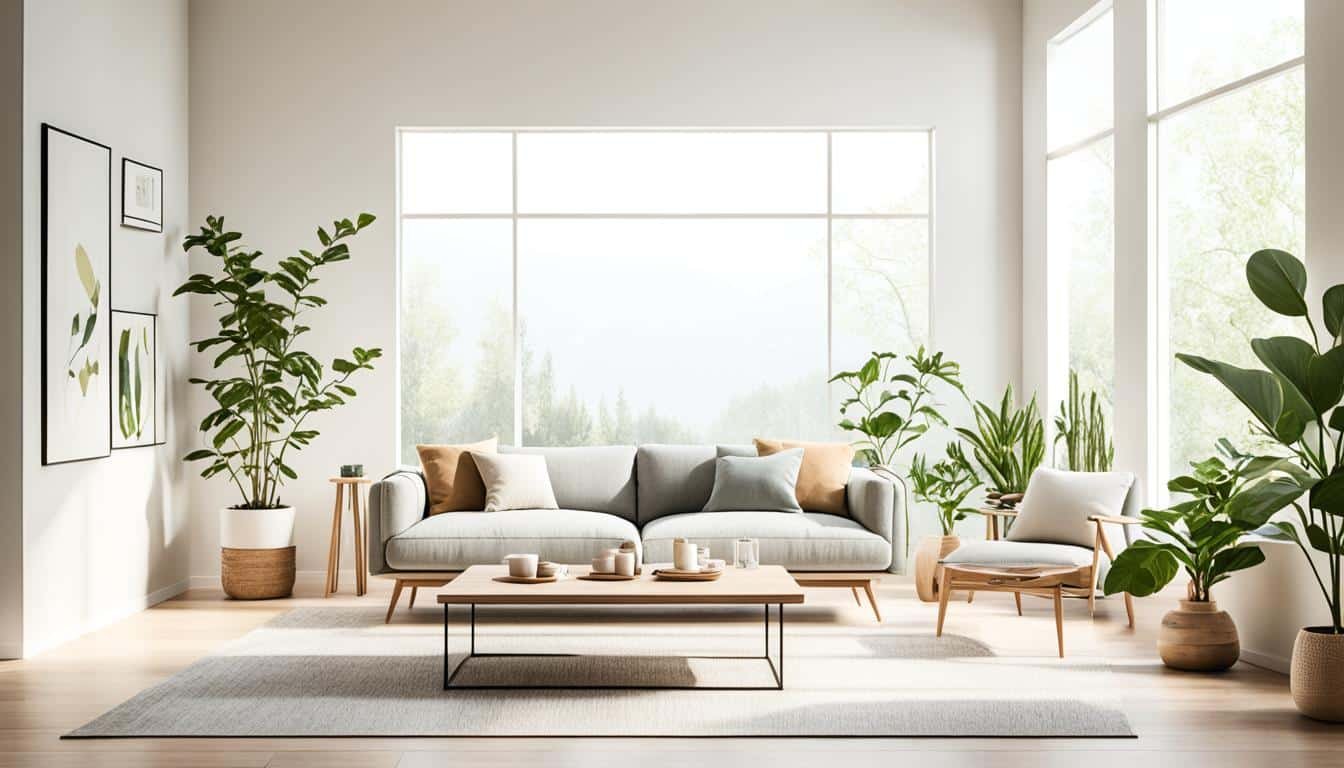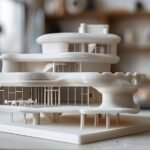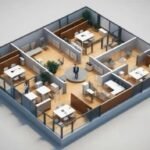Interior architecture plays a significant role in shaping human behavior. The design of our daily living environments, including lighting, colors, configuration, and materials, can have a profound impact on our psychological well-being. Creating spaces that address the social and psychological needs of the occupants is crucial for promoting a positive and efficient environment.
Key Takeaways:
- Interior architecture has a direct impact on human behavior.
- Designing spaces that address psychological needs promotes well-being.
- Factors such as lighting, colors, and materials affect our emotions and behaviors.
- Understanding the psychology of space is essential for creating positive environments.
- Interior design has evolved to prioritize the well-being of occupants.
The Psychology of Space and Human Behavior
Environmental psychology, also known as space psychology, explores the intricate relationship between individuals and the spaces they inhabit. It delves into how different elements of the physical environment can shape human behavior, emotions, and overall well-being. This field of study examines the interaction between people and spaces, recognizing that our surroundings can significantly impact our sensory stimuli, feelings, and practices.
Factors such as lighting, colors, acoustics, and materials play instrumental roles in creating an environment that stimulates our senses and influences our psychological state. These elements can evoke various emotions and behaviors, ranging from serenity and tranquility to energy and productivity.
The way we design and organize our environments has the power to enhance or hinder our well-being and experiences of a space. Understanding the psychological effects of these elements is crucial for architects, interior designers, and planners to create spaces that promote positive emotions, comfort, and usability.
By comprehending the psychology of space, professionals can design surroundings that cater to the needs of occupants. This knowledge informs decisions on lighting fixtures, color palettes, materials, and acoustics, granting the ability to curate spaces that promote well-being, productivity, and positive social interactions.
Exploring the psychology of space provides insights into how our environment can shape our behavior, emotions, and overall quality of life. By understanding the interaction between people and spaces, professionals can craft spaces that foster optimal human experiences and promote a sense of well-being.
Benefits of Understanding the Psychology of Space
- Enhanced well-being and mental health through thoughtful design
- Improved productivity and creativity in workspaces
- Promotion of positive social interactions and sense of community
- Creation of environments that cater to specific needs and practices
- Optimization of sensory stimuli to evoke desired emotional responses
By leveraging the principles of environmental psychology, designers and architects can create environments that positively impact human behavior and emotions. This knowledge transforms spaces into holistic experiences, enhancing our daily lives and overall well-being.
The Impact of Interior Space on Human Psychology
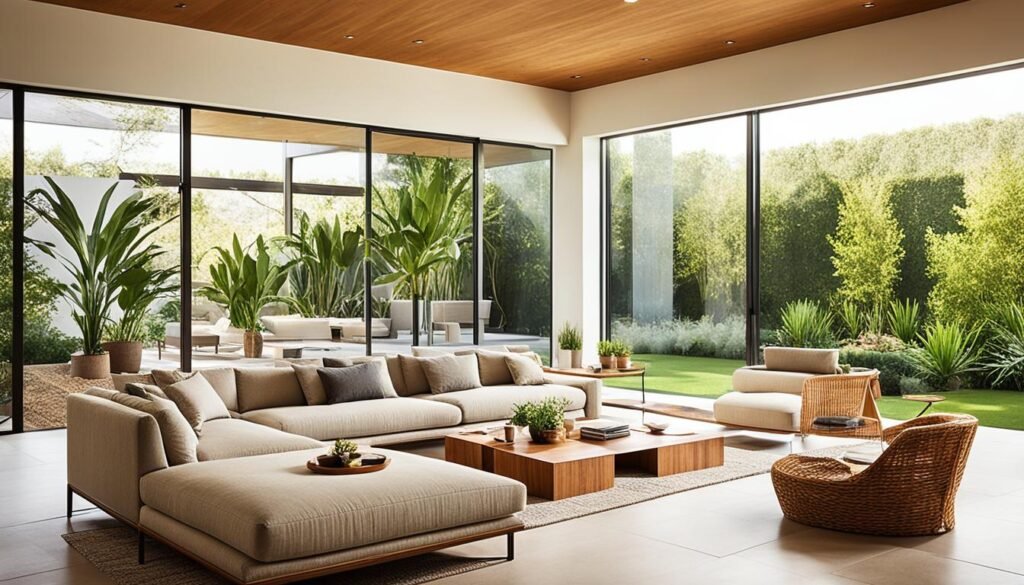
Interior space has a profound impact on our subconscious, influencing our emotions and perceptions. The way a space is designed and structured can have a direct effect on how we feel and behave within it. Understanding the role of interior space in shaping human psychology is crucial for architects and designers who have the responsibility of creating spaces that promote well-being and positive experiences for people.
The geometry of the space we occupy plays a significant role in triggering specific responses in our brain. The arrangement of walls, windows, and furniture can subconsciously influence our mood and behavior. For example, bright and open spaces can evoke feelings of energy and stimulation, while enclosed and cozy spaces can create a sense of relaxation and intimacy.
Emotions and perceptions are closely linked to interior space. The colors, lighting, and materials used in a space can evoke different emotional responses. Warm colors like red and orange can create a sense of warmth and excitement, while cool colors like blue and green can promote calmness and serenity.
Architects and interior designers have the responsibility to create spaces that positively impact the psychological well-being of individuals. By designing spaces that consider the emotional and sensory needs of occupants, architects can enhance the overall experience and create environments that promote positive emotions and behaviors.
| Impacts of Interior Space on Human Psychology | Examples |
|---|---|
| Emotions and Perceptions | Color schemes, lighting, and materials can evoke different emotions. |
| Spatial Configuration | The arrangement of furniture and walls can influence mood and behavior. |
| Sensory Stimulation | The use of textures, scents, and sounds can elicit specific responses. |
| Geometry of Space | The shape and layout of a space can impact spatial cognition and navigation. |
Creating interior spaces that prioritize the well-being and psychological needs of individuals requires a deep understanding of how the environment impacts human psychology. By utilizing research-driven design principles and considering the geometry of space, architects can create environments that enhance the experiences of occupants and contribute to their overall well-being.
The Evolution of Interior Design and Space Usage
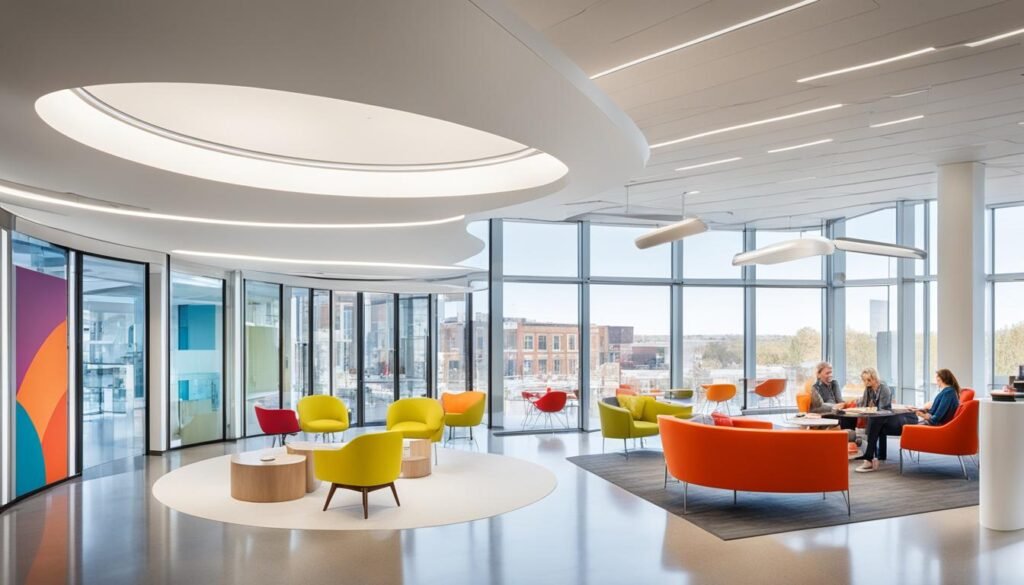
The concept of functionality in interior design has evolved over time. During the Industrial Revolution, the mass population influx into non-equipped cities led to a cramming of individuals into small spaces. The primary focus was on productivity and efficiency, without considering the psychological impact of the space on the occupants.
As the industrial revolution progressed, modern architecture emerged to address the challenges posed by the mass population influx. The rise of modern architecture introduced new principles that emphasized the efficient usage of space. Architects began to explore innovative ways to maximize functionality and create spaces that met the growing needs of the expanding urban population.
The usage of space became a critical consideration as designers sought to optimize the limited available area. The rise of modern architecture introduced concepts such as open floor plans, modular furniture, and flexible layouts to ensure that spaces could adapt to evolving needs.
Urbanization and the Need for Efficient Design
The mass population influx during the Industrial Revolution resulted in overcrowded cities and limited living spaces. The challenge was to accommodate the growing population within constrained urban areas while ensuring functionality and livability.
Designers had to find creative solutions to maximize the usage of space, utilizing every available square inch effectively. Strategic placement of furniture, compact designs, and multi-functional elements became crucial in creating livable environments within limited spaces.
The Shift towards User-Centered Design
It was later recognized that solely focusing on productivity and efficiency was not sufficient. The rise of modern architecture brought a new understanding of the psychological impact of the built environment on human behavior.
- Acknowledging the importance of psychological well-being, designers began to prioritize creating spaces that catered to the needs and preferences of the occupants.
- Functionality alone was no longer the sole criterion for success. The aim was to design spaces that would enhance the well-being and quality of life for the users.
- This shift marked the start of a user-centered approach in interior design, considering not only the functionality of the space but also the impact on the psychological well-being of the occupants.
As interior design evolved, it incorporated elements such as aesthetics, comfort, and sensory stimulation, alongside functionality. The goal of creating positive environments that support the diverse needs and preferences of individuals became paramount.
| Industrial Revolution | Modern Architecture |
|---|---|
| Focus on productivity and efficiency | User-centered design |
| Limited living spaces due to mass population influx | Optimized usage of space |
| Underdeveloped understanding of psychological impact | Prioritization of user well-being |
| Maximization of available space | User-centered spaces catered to individual needs |
Incorporating Psychology into Interior Design
With the evolution of interior design, there is a greater recognition of the importance of psychology in creating functional and appealing spaces.
Designers now consider the psychological impact of the space on the emotions, behavior, and well-being of the occupants. This understanding enables them to design spaces that enhance comfort, promote positive moods, and foster a sense of well-being.
By taking into account the psychological and emotional needs of individuals, interior design today aims to create spaces that are not only visually pleasing but also contribute to the overall well-being and satisfaction of the occupants.
Designing for Psychological Well-being

Architecture and interior design have a significant impact on our overall well-being. The design of our built environment can greatly influence our physical and psychological factors, ultimately affecting our daily experiences and mental state. When creating spaces, it is essential to consider various factors that promote psychological well-being, including safety, social connectedness, ease of movement, and sensory stimulation.
Safety is a fundamental aspect of a well-designed space. It encompasses both physical safety, such as the absence of hazards, and psychological safety, ensuring individuals feel secure and protected in their environment. By creating a safe space, individuals can focus on their tasks and activities without unnecessary worry or stress.
Social connectedness is another crucial factor in promoting psychological well-being. Designing spaces that encourage interaction and collaboration can foster a sense of belonging and community. These spaces may include communal areas, such as shared workspaces or gathering spaces, where individuals can connect and engage with others.
Easy movement within a space is essential for promoting physical and psychological well-being. A well-designed layout allows for efficient and intuitive navigation, minimizing obstacles and promoting a sense of flow. By eliminating physical barriers and designing accessible spaces, individuals can move freely and comfortably, contributing to their overall sense of well-being.
Sensory stimulation is an integral part of creating a positive environment for psychological well-being. Thoughtful consideration of lighting, colors, textures, and acoustics can create a multi-sensory experience that enhances mood and cognitive function. Incorporating elements of nature, such as natural light and greenery, can provide a connection to the outdoors and promote a sense of calm and relaxation.
Designing spaces with well-being in mind can profoundly impact our daily lives and mental health. By prioritizing factors such as safety, social connectedness, ease of movement, and sensory stimulation, architects and interior designers can create environments that support and enhance psychological well-being, leading to a more positive and fulfilling experience.
Creating a space that prioritizes psychological well-being requires a holistic approach, considering the physical and psychological factors that contribute to overall health and happiness. By understanding and addressing these factors, architects and interior designers have the opportunity to create spaces that positively impact individuals’ lives, promoting a sense of well-being and enhancing the human experience.
| Factors for Designing Psychological Well-being | Examples |
|---|---|
| Safety | Implementing security measures, ensuring proper lighting in parking areas, and using durable materials |
| Social Connectedness | Creating communal spaces, such as lounges or outdoor seating areas, to encourage interaction |
| Ease of Movement | Designing wide hallways and accessible entrances to accommodate individuals with mobility challenges |
| Sensory Stimulation | Using natural materials and incorporating elements of nature, such as plants and natural light |
The Role of Design Elements in Shaping Behavior
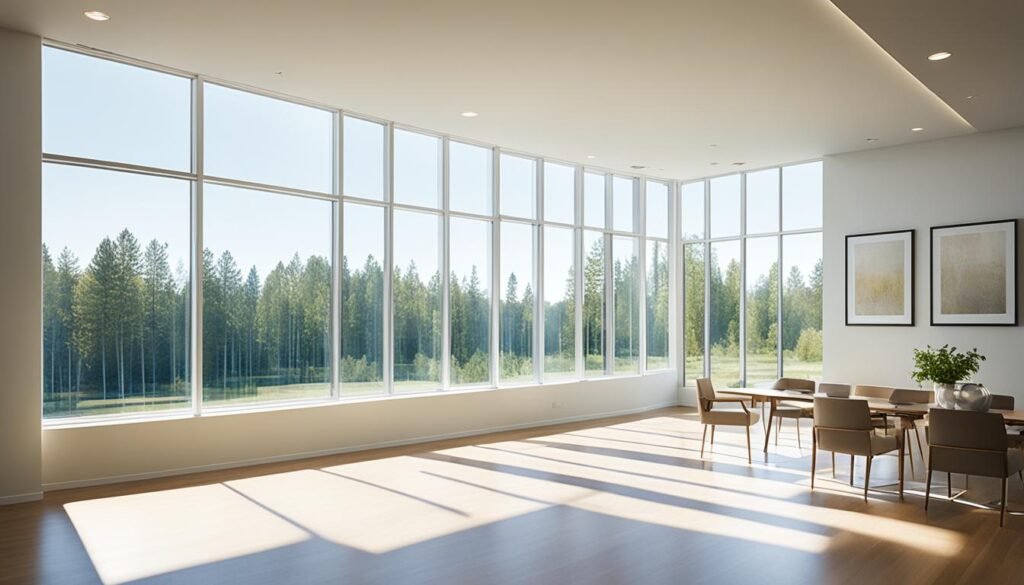
Design elements play a crucial role in shaping human behavior, influencing our emotions, and enhancing our experiences. Elements such as light, color, balance, proportion, symmetry, and rhythm have a significant impact on our psychological state. Understanding how these design elements affect behavior is essential for creating interior spaces that promote well-being and optimize human interaction.
Light, for example, can greatly influence our mood and energy levels. Research has shown that exposure to natural light has a positive impact on our mental health and overall well-being. Incorporating ample natural light into interior spaces can create a sense of openness and improve concentration and productivity. In contrast, lighting with warmer tones can create a cozy and relaxed environment.
Color is another powerful design element that can evoke specific emotions and influence behavior. Warm colors such as red, orange, and yellow can create a sense of energy and excitement, while cooler colors like blue and green can promote calmness and relaxation. By carefully selecting and incorporating colors into interior design, designers can shape behavior and create atmospheres that cater to specific needs.
Balance, proportion, and symmetry are principles of design that contribute to a harmonious and visually pleasing space. When these elements are incorporated effectively, they can bring a sense of order and stability. This can positively impact our psychological state, making us feel grounded and at ease. By creating balanced and proportional interior spaces, designers can promote a sense of well-being and enhance the overall experience.
Rhythm refers to the visual flow and repetition of design elements within a space. It creates a sense of movement and can impact our perception of space. A well-designed rhythm can guide our eyes and attention through a room, creating a more engaging and interactive experience. By incorporating rhythm into interior architecture, designers can create spaces that stimulate our senses and enhance our overall enjoyment.
Sensory stimulation is an essential aspect of interior design. Engaging our senses through texture, sound, and smell can profoundly impact our mood and behavior. Textures can evoke feelings of comfort and coziness, while certain sounds and scents can create a calming or energizing environment. By incorporating sensory stimulation into interior spaces, designers can create experiences that amplify human behavior and evoke emotional responses.
Overall, the use of design elements in interior architecture has a profound influence on human behavior and well-being. By leveraging the power of light, color, balance, proportion, symmetry, rhythm, and sensory stimulation, designers can shape behavior, create positive environments, and enhance the overall experience of users.
The Psychology of Different Interior Spaces
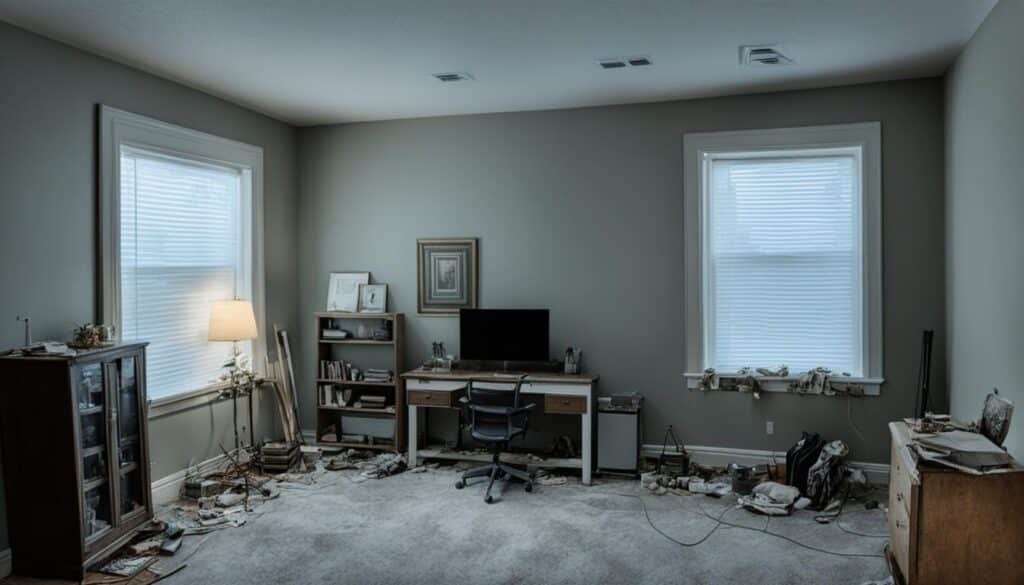
Different interior spaces have the power to elicit a wide range of emotional responses in individuals. While some spaces may induce feelings of anxiety and discomfort, others create a serene and calming atmosphere. These varied responses can be attributed to the field of environmental psychology, which aims to understand the subconscious influences that different spaces have on our behavior and emotions.
Research in environmental psychology explores the relationship between individuals and the spaces they inhabit. It delves into how factors such as layout, lighting, colors, acoustics, and materials can evoke specific emotional and behavioral responses in people. By delving into the subconscious influences that shape our experiences within a space, designers can create environments that promote positive experiences and overall well-being.
In interior design, the knowledge gained from environmental psychology research can be applied to the creation of spaces that enhance mood, ease stress, and promote relaxation. By carefully considering the psychological impact of different design elements, such as color palettes, lighting techniques, and spatial configurations, interior designers can curate environments that foster positive experiences and well-being.
“The design of interior spaces shapes how we feel and behave within them. By understanding the psychological impact of our surroundings, designers can create spaces that actively promote positive experiences and well-being.” – Dr. Jane Reynolds, Environmental Psychologist
By harnessing the principles of environmental psychology, interior designers can transform anxiety-inducing spaces into serene sanctuaries. They can create environments that cater to specific emotional needs and enhance the overall quality of life for the occupants. As research in this field continues to advance, the integration of psychological principles in interior design will undoubtedly lead to more thoughtful and impactful spaces.
Key Points:
- Different interior spaces evoke different emotional responses, ranging from anxiety to serenity.
- Environmental psychology research focuses on understanding the subconscious influences that spaces have on our emotions and behavior.
- Interior designers can apply this knowledge to create spaces that promote positive experiences and well-being.
- By considering design elements like color, lighting, and spatial configuration, designers can transform anxiety-inducing spaces into serene environments.
Applying Psychology to Design Projects
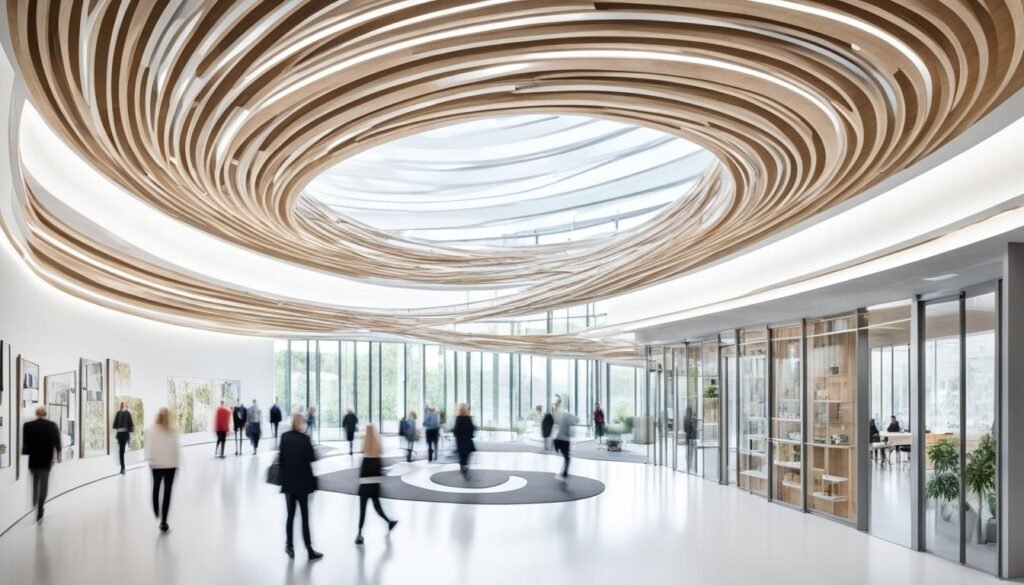
When it comes to interior architecture, understanding human behavior is crucial for creating spaces that have a positive impact on individuals. By applying psychology to design projects, designers can optimize productivity, increase sales, and promote well-being in healthcare settings.
Enhancing Workplace Productivity
Productivity is a key consideration in the design of workspaces. Through evidence-based design principles, interior architects can create environments that foster focus, collaboration, and efficiency. By incorporating architectural cues such as natural lighting, ergonomic furniture, and flexible workstations, workplaces can be optimized for employee performance.
Driving Sales in Retail Environments
The layout and design of retail spaces can significantly influence consumer behavior and drive sales. By understanding consumer psychology and incorporating effective design elements, such as strategic product placement, appealing visual displays, and comfortable shopping environments, retailers can create experiences that attract and engage customers, ultimately boosting sales.
“Design is not just what it looks like and feels like. Design is how it works.” – Steve Jobs
Promoting Recovery in Healthcare Settings
In healthcare design, evidence-based principles can improve patient outcomes and accelerate recovery. By creating environments that prioritize safety, comfort, and social connectedness, interior architects can help reduce stress and anxiety, contributing to positive patient experiences and better overall healthcare outcomes.
Architectural Cues for Behavior Reinforcement
Architectural cues play a vital role in shaping behavior within specific spaces. Safety features, such as clear signage and intuitive navigation, can promote a sense of security. Incorporating elements that foster social connectedness, such as communal areas and open layouts, can encourage interaction and collaboration. By strategically implementing these cues, interior architects can influence desired behaviors and create spaces that support the needs of individuals.
Incorporating Evidence-Based Design Principles
Evidence-based design involves using research, data, and proven strategies to inform design decisions. By embracing this approach, interior architects can create spaces that are not only aesthetically pleasing but also support the physical and psychological well-being of occupants. It involves a thorough understanding of how architectural elements, materials, colors, and lighting impact human behavior and emotions.
By applying psychology to design projects, interior architects can create environments that enhance productivity, sales, and well-being. Through evidence-based design principles and careful consideration of architectural cues, the impact of design on human behavior can be harnessed to create positive and engaging spaces.
Understanding Interior Design and Atmosphere Creation
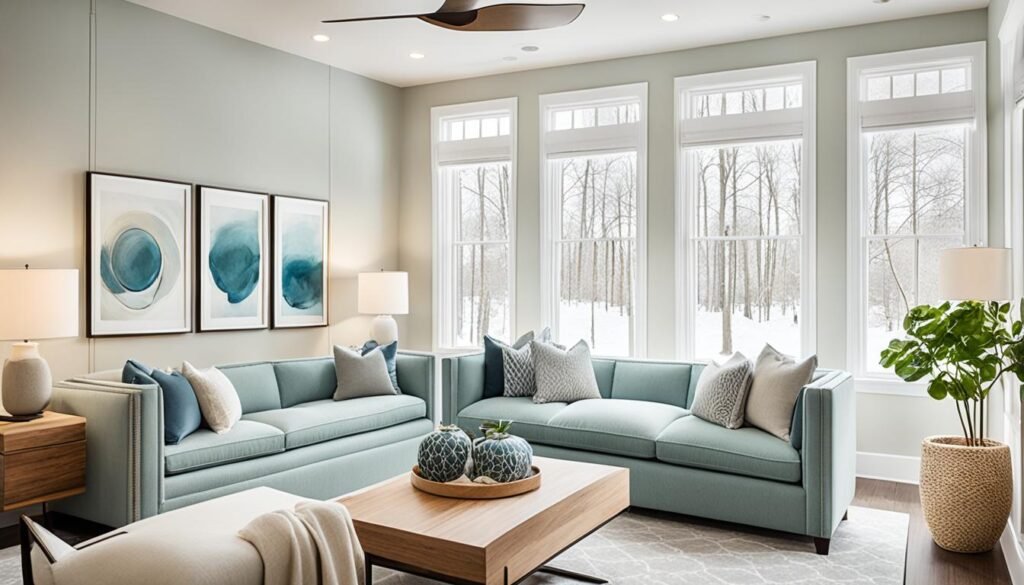
Interior design is a multifaceted discipline that revolves around the creation of a specific atmosphere and mood within a space. It combines various elements, such as colors, light, textures, and furnishings, to evoke a desired ambience that resonates with the occupants.
Interior designers possess a unique set of skills and expertise to manipulate these design elements effectively. By strategically harnessing the power of colors and light, they can transform the mood of a room and influence human behavior.
“Color is a power which directly influences the soul.” – Wassily Kandinsky
Colors play an integral role in interior design and have a profound impact on the atmosphere of a space. For example, the use of neutral colors, such as whites and beiges, combined with an abundance of natural light, can create an environment of tranquility and serenity. On the other hand, darker colors, such as deep blues or rich browns, can evoke a sense of opulence and comfort.
Lighting is another crucial element in setting the mood and ambience of an interior space. Different types of lighting, such as natural light, task lighting, and ambient lighting, can significantly impact the overall atmosphere. Soft, warm lighting can create a cozy and intimate setting, while bright, cool lighting can promote focus and productivity.
Color and Light Combinations for Different Atmospheres
| Atmosphere | Color Palette | Lighting |
|---|---|---|
| Serenity and Tranquility | Neutral colors (whites, beiges, pastels) | Abundance of natural light |
| Luxury and Comfort | Deep blues, rich browns, velvety textures | Warm, ambient lighting with dimmers |
| Creativity and Vibrancy | Bright colors (yellows, oranges, reds) | Good balance of natural and artificial lighting |
Understanding the impact of colors and light in interior design is essential for creating spaces that have a specific atmosphere and influence human behavior. By carefully selecting the right color palettes and lighting schemes, designers can curate the mood and ambience that aligns with the intended purpose and desired emotions in a room.
Incorporating Social and Psychological Aspects in Design

When it comes to designing spaces, incorporating social and psychological aspects is crucial to creating environments that meet the needs of individuals. Designers must consider functionality, human needs, and analyzing the interior atmosphere to enhance the overall experience of the built environment.
Understanding the psychological impact of design choices is essential for creating spaces that enhance reality and positively influence human behavior. By being responsive to human needs, designers can develop spaces that promote well-being and improve daily living experiences.
Incorporating responsive design principles allows designers to adapt to the changing needs and preferences of users. This approach ensures that spaces remain functional and relevant, meeting the diverse demands of individuals.
One aspect of incorporating social and psychological aspects is the analysis of the interior atmosphere. Designers carefully consider the use of colors, lighting, textures, and materials to create specific moods and evoke desired emotional responses. This enhances the overall atmosphere and contributes to the well-being of individuals within the space.
“Good design is innovative, useful, and aesthetic. It understands the social and psychological aspects that shape human behavior, creating spaces that enhance reality and meet the needs of users.”
By prioritizing functionality and human needs, designers ensure that the built environment caters to individuals’ requirements and fosters a positive experience. Responsive design allows for flexibility, enabling spaces to adapt to changing circumstances and accommodate various activities.
In summary, the incorporation of social and psychological aspects in design is essential for creating spaces that enhance reality, meet human needs, and positively influence behavior. Designers must understand the psychological impact of their choices and be responsive to the dynamic nature of human interactions within the built environment.
Example of Design Elements and Their Psychological Impact
| Design Element | Psychological Impact |
|---|---|
| Color | Elicits specific emotions and affects mood |
| Lighting | Influences energy levels and overall ambiance |
| Texture | Affects tactile experience and adds depth to a space |
| Layout and Spatial Organization | Impacts flow, movement, and social interactions |
| Materials | Contribute to the overall sensory experience |
The Connection Between Design and Human Emotions
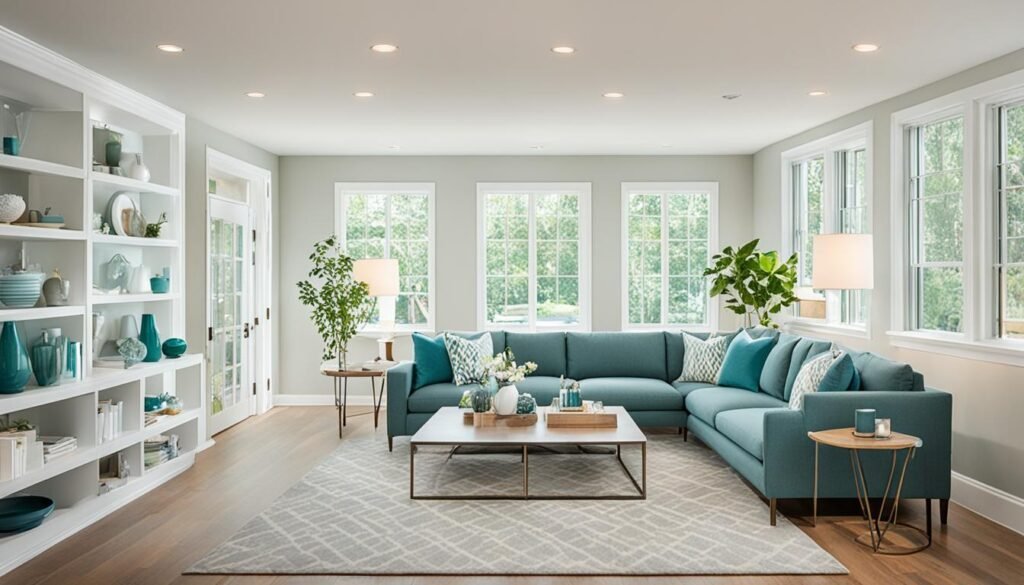
Design is a powerful influencer of human emotions, behavior, and overall quality of life. The aesthetic appeal of a space can evoke profound emotional responses and significantly impact mental health and well-being. Whether it’s the colors, lighting, or layout, every design element plays a role in shaping our mood, behavior, and overall experience within a space.
Aesthetics, in particular, have the ability to evoke positive emotions and create a sense of harmony. When a space is visually pleasing and well-designed, it can have a calming effect, reducing stress and anxiety. The use of soothing colors, natural materials, and balanced proportions can contribute to a positive and welcoming atmosphere.
Furthermore, the effects of design on mental health and well-being are supported by interdisciplinary research that combines architecture, neuroscience, and behavioral sciences. This research helps us better understand how design elements and spatial configurations influence human emotions and behaviors.
“The aesthetic quality of a well-designed space can contribute to a positive mental state, enhancing overall well-being and quality of life.”
Through interdisciplinary research, designers can glean insights into the connection between design and mental health. This knowledge allows them to create environments that promote positive experiences, improve well-being, and enhance overall quality of life. By utilizing evidence-based principles and understanding the psychology behind design, designers can influence human behavior in a way that supports mental health and well-being.
Interdisciplinary Research:
Interdisciplinary research plays a pivotal role in enhancing our understanding of how design impacts human emotions and behavior. By combining the expertise of architects, neuroscientists, and behavioral scientists, we gain valuable insights into the intricate relationship between design and human psychology.
Researchers conduct studies to determine the effects of different design elements on mood, behavior, and overall well-being. These studies involve analyzing how color palettes, lighting, spatial layouts, and other design factors affect individuals in various settings.
The findings from interdisciplinary research empower designers to create spaces that not only meet functional requirements but also optimize human experiences. By incorporating evidence-based design principles, designers can influence behavior, promote positive emotions, and ultimately improve the quality of life for individuals interacting with designed environments.
Key Design Elements and Their Emotional Impact
| Design Element | Emotional Impact |
|---|---|
| Color | Elicits different emotional responses (e.g., blue induces calmness, while red may stimulate energy or excitement). |
| Lighting | Affects mood and can create an inviting or dramatic atmosphere. |
| Layout | Influences behavior and social interactions within a space. |
| Materials | Arouses tactile sensations and can evoke feelings of comfort or luxury. |
The combination of interdisciplinary research and an understanding of design elements allows designers to intentionally create environments that support human emotions, behavior, and overall well-being. By harnessing the power of design, we can positively impact the way we experience and interact with the spaces around us.
Designing spaces that prioritize aesthetics, mood, behavior, and overall quality of life is not only valuable but essential for our well-being and the well-being of future generations.
Also Read: Creative Kitchen Sink Design Ideas For Your Home
Conclusion
Interior architecture plays a vital role in shaping human behavior and well-being. By understanding the impact of design elements on human behavior and emotions, designers can create spaces that promote positive behaviors and improve the overall quality of life. Designing spaces that consider the social and psychological needs of individuals can create positive environments that enhance daily living experiences.
The use of interior architecture to create positive environments has a significant impact on human well-being. Factors such as lighting, colors, configuration, and materials influence our psychological state, promoting feelings of comfort, relaxation, and productivity.
Creating positive environments through interior design also contributes to social connectedness and a sense of safety. Well-designed spaces that prioritize safety features and provide opportunities for social interaction can enhance the overall well-being of individuals.
To create positive environments, interior designers and architects must continue to stay updated with research and evidence related to the impact of design on human behavior. This interdisciplinary approach, combining architecture, psychology, and neuroscience, will ensure that future design projects prioritize the well-being of occupants and enhance the quality of daily living experiences.
FAQs
Q: What is the difference between interior design and interior architecture?
A: Interior design focuses on the aesthetic aspects of the interior space, such as decorations and furnishings, while interior architecture is more concerned with the structural elements and layouts of the space.
Q: Why is interior architecture important in shaping human behavior?
A: Interior architecture plays a crucial role in shaping human behavior by creating spaces that are conducive to specific activities, emotions, and interactions, influencing how individuals engage with their environment.
Q: How does lighting design impact interior architecture and design?
A: Lighting design is an essential element in interior architecture as it can enhance the ambiance, functionality, and aesthetics of a space, affecting the overall experience and behavior of its occupants.
Q: What is the role of an interior architect in designing interior spaces?
A: An interior architect is responsible for conceptualizing and executing designs that not only look appealing but also function effectively, considering aspects such as spatial planning, material selection, and environmental sustainability.
Q: What education is required to pursue a career in interior architecture and design?
A: To become an interior architect or designer, individuals typically need a bachelor’s degree in interior architecture and design or a related field. Some may also choose to pursue a master’s degree for further specialization.
Q: How can interior designers benefit from internships during their studies?
A: Internships provide interior design students with valuable hands-on experience, networking opportunities, and a chance to apply theoretical knowledge in real-world settings, helping them prepare for a successful career in the field.
Q: What does a degree program in interior architecture typically cover?
A: A degree program in interior architecture usually covers a range of topics, including design principles, spatial planning, technical drawing, materials and finishes, sustainability, and professional practice, equipping students with the necessary skills and knowledge for the industry.
